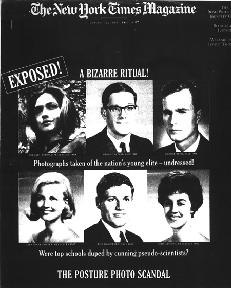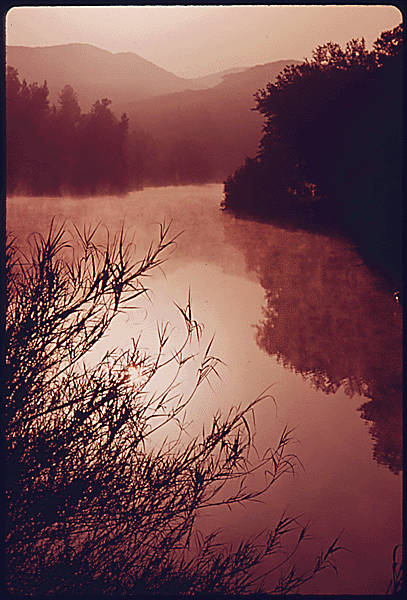 Diane Kaplan, of Yale University Library’s Manuscripts and Archives unit, started off Session 404 (officially titled Exploring the Headwaters of the Revenue Stream) by thanking everyone for showing up for the last session of the day. This was a one hour session that examined ways to generate new funds through e-commerce . Three different e-commerce case studies were presented, followed by a short question and answer period.
Diane Kaplan, of Yale University Library’s Manuscripts and Archives unit, started off Session 404 (officially titled Exploring the Headwaters of the Revenue Stream) by thanking everyone for showing up for the last session of the day. This was a one hour session that examined ways to generate new funds through e-commerce . Three different e-commerce case studies were presented, followed by a short question and answer period.
University of Wyoming’s American Heritage Center
Mark Shelstad‘s presentation, “Show Me the Money: Or: How Do We Pay for This?”, detailed the approach taken by the University of Wyoming‘s American Heritage Center (AHC) to find alternate revenue streams. After completing a digitization project in the fall of 2004, the AHC had to figure out how to continue their project after their original grant money ran out.
Since they didn’t have a lot of in-house resources, they chose Zazzle.com for their effort to profit from their existing high resolution images. They can earn up to 17% from the sales through a combination of affiliate sales and profits from the sale of products featuring American Heritage Center images.
They had a lot of good reasons for choosing Zazzle.com. Zazzle.com already had an existing ‘special collections’ area, meaning that their images would have a better chance of being found by those interested in their offerings (for example – take a look at the Library of Congress Vintage Photos store). Zazzle.com also did not require an exclusive license to the images. The American Heritage Center Zazzle on-line store opened in 2005.
Currently they are making about $30 a month in royalties from 200 images. Mark pointed out that everyone needs to keep in mind that the major photo provider, Corbis, has yet to turn a profit in online photo sales. He also mentioned a website called Cogteeth.com that lets you click on any image and use those images on t-shirts, mugs.. etc.
Near the end of his talk, Mark shared an amazing idea to create a non-profit that would be a joint organization for featuring and selling products using archival images. I love it! It is easy to see that many archives are small and don’t have the infrastructure to create and run their own e-commerce websites. At the same time, general sites that let anyone set up a store to sell items with custom images on them threaten to loose the special nature of historical images in the shuffle. Even the special collections section of Zazzle lumps the American Heritage Center and the Library of Congress collections with Disney and Star Wars. I would love to see this idea grow!
Minnesota Historical Society
Kathryn Otto of the Minnesota Historical Society (MHS) spoke next. She first gave an overview of traditional services provided by MHS for a fee, such as photocopies, reader-printer copies, microfilm sales, media sales, inter-library loan fees, classes and photograph sales. MHS also earned income via standard use fees and research services.
The first e-commerce initiative at MHS was the sale of Minnesota State Death Certificates from 1904 – 2001. Made available via the Minnesota Death Certificate Index they provide the same data as Ancestry.com, but the MHS index provides a better search interface. They have had users tell them that they couldn’t find something on Ancestry.com – but that they were able to find what they needed on the MHS site.
To their existing Visual Resources Database, MHS also added a buy button for most images. Extra steps were added into the standard buy process to deal with the addition of a use fee depending on how the purchaser claims the image will ultimately be used. One approach that did not work for them was to offer expensively printed pre-selected images. The historical society sells classes online and can handle member vs non-member rates. TheVeterans Graves Registration Index is a tiny database that was created by reusing the interface used for the death certificates.
The Birth Certificate Index provides “single, non-certified copies of individual birth certificates reproduced from the originals” via the website.. while “[o]fficial, certified copies of these birth certificates are available through the Minnesota Department of Health.” The MHS site provides much faster and easier service than the Department of Health as can be seen from this page detailing how to order a non-certified copy of a birth record from the DOH – which requires printing, filling out and either faxing or snail mailing a form.
Features to keep in mind as you branch into in e-commerce:
- Statistics – Consider the types of statistics you want. Their system just gave them info about orders – not how much they made.
- Sales tax – Figure out how is it handled
- Postage/Handling fees – Look at the details! The MHS Library-Archives was stuck with the Museum Store’s postage rates because the e-commerce system could not handle different fees for different types of objects.
- Can’t afford credit card fees? Consider PayPal.
- Advertise what you are selling on your own website.
Godfrey Memorial Library, Middletown, CT
The final panelist was Richard Black, Director of the Godfrey Memorial Library in Middletown, Connecticut. The Godfrey is a small, non-profit, genealogical research library with approximately 120,000 genealogical items. They currently have 5 full time staff and 60 volunteers.
Services they provide:
- an online subscription portal for genealogical research (see a list of resources available to subscribers )
- quick search service – 30 minutes of search by a volunteer
- American Genealogical Biographical Index (AGBI) – currently Ancestry.com has right to use the AGBI for 1 more year
- Access to OCLC WorldCat
- …and more
About 3 years ago they had exhausted all of their endowment money and faced the strong possibility of closing the doors. They were down to one full time librarian and a few volunteers and were dependent mostly on donations and some minor income from other sources/services.
They had only a few options open to them:
- find more money from other sources
- merge with another library
- close the doors
- sell some of the content
- others??
The first approach to raise funds was to create a subscription website. The Godfrey acquired Heritage Quest census records and added other databases as resources allowed. Subscriptions were sold for $35 a year. The board thought they might be lucky to get 100 subscriptions.. but they actually got approximately 14,000!
Now the portal provides access to sites for which a premium has been paid (so that subscribers don’t have to pay), sites that are available free on the Internet (but made easier to find) and sites unique to Godfrey, including digitized material in the library and other material that has been made available to them. They just added 95,000 Jewish grave-sites – brought to them by a local rabbi. Another recent addition was a set of transcriptions of a grave-site made as an Eagle Scout project. They also negotiated to have their books digitized for them for free. The company performing the digitization will pay a royalty to Godfrey as the books are used.
The costs to acquire data for the portal includes $60,000 a year for access to premium sites, the cost to digitize and transcribe unique content (there are opportunities to partner and reduce costs) and the cost to acquire patrons. The efforts of the Godfrey staff and volunteers is ‘free’ – but costs time.
The Godfrey subsequently lost access to the Heritage Quest material. This was like taking the anchor store out of the corner of a mall. It forced them to diversify their revenue streams and watch for new opportunities.
Current revenue source distribution:
- online portal 45%
- annual appeal 10%
- patron requests 5%
- contract services 35% (OCLC analytical cataloging that they do)
- misc 5%
The endowment funds have been restored and the Godfrey’s staff is now growing again.
Questions
Question: Did you meet resistance in your institutions?
Answer: No.. Minnesota said they had such success that the 2 questions they here now are A) What do we put online next? B) How long can they protect their income from the rest of the institution?
Question: (From someone from a NJ archives) Is there a way to do e-commerce with government records and not have the money ‘stolen’ from them?
Answer: Minnesota – The department of health was happy for death and birth certificates business to go away? They do worry about the future when they might try to make a marriage index – because that territory is already ‘owned’ by a group that wants to keep that income.
Question: When you charge for use fees – are there people who don’t pay them?
Answer: Minnesota: Probably – no way to really know.
Mark (American Heritage Center): Our images are public domain – they can do what they like with them.
Question: Do you brand your images?
Answer: Mark: Yes.. a logo and URL goes with the images.
My Thoughts
I was particularly impressed by how much information was conveyed in the course of the 1 hour session. My personal highlights were:
- As I mentioned above, I want Mark’s idea for a non-profit to sell co-located products based on archival images to gain support and momentum.
- I was pleased by the point that the MHS makes money from their Minnesota Death Certificate Index partly due to their improved and powerful search interface. The data is available elsewhere – but they made it easier to find information, so they will become the destination of choice for that information.
- The Godfrey’s story is inspirational. In an age when we hear more and more often about archives and libraries being forced to cut back services due to funding shortfalls, it is great to hear about a small archives that pulled themselves back from the brink of disaster by brave experimentation.
These three case studies gave a great glimpse of some of the ways that archives can get on the e-commerce bandwagon. There is no magic here – just the willingness to dig in, figure out what can be done and try it. That said – there is definitely lots of room to learn from others successes and mistakes. The more real world success and failure stories archives share with the archival community about how to ‘do’ e-commerce, the easier it will be for each subsequent project to be a success.
As is the case with all my session summaries from SAA2007, please accept my apologies in advance for any cases in which I misquote, overly simplify or miss points altogether in the post above. These sessions move fast and my main goal is to capture the core of the ideas presented and exchanged. Feel free to contact me about corrections to my summary either via comments on this post or via my contact form.

